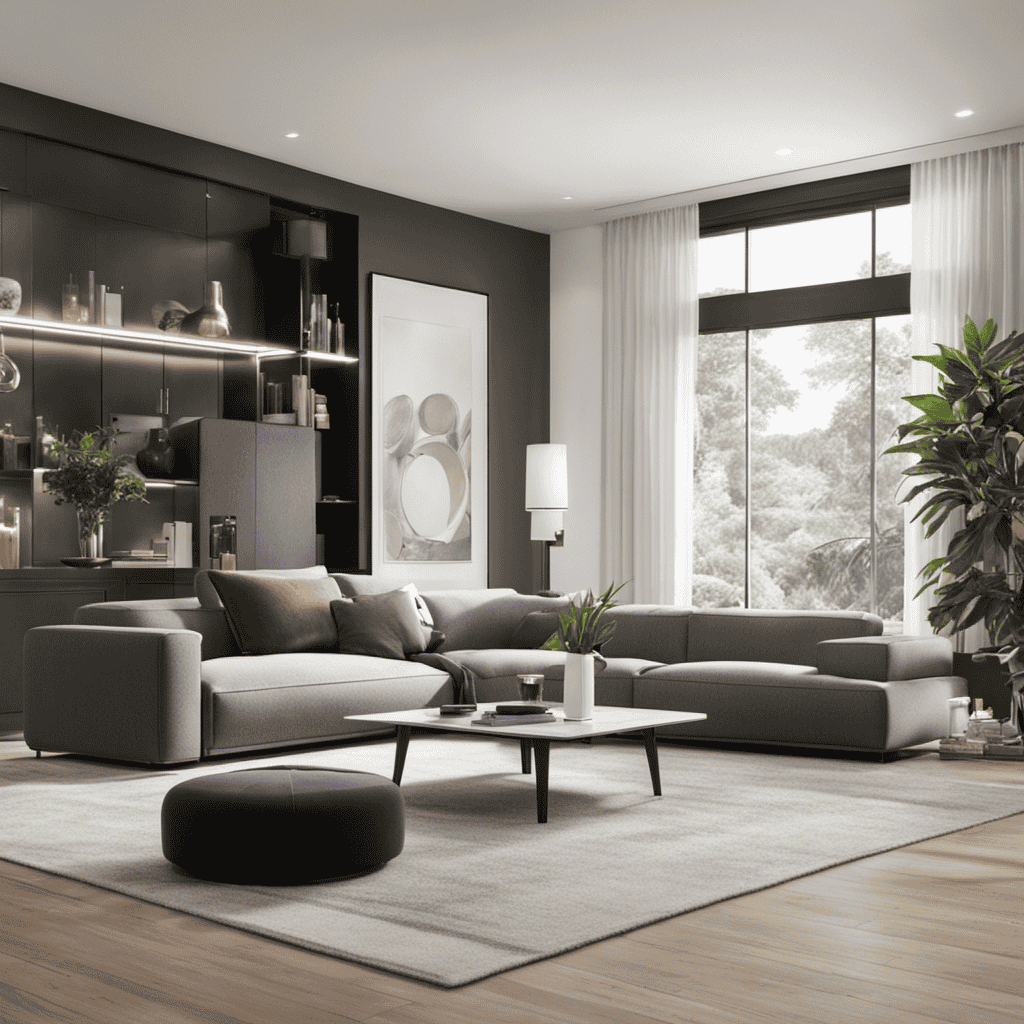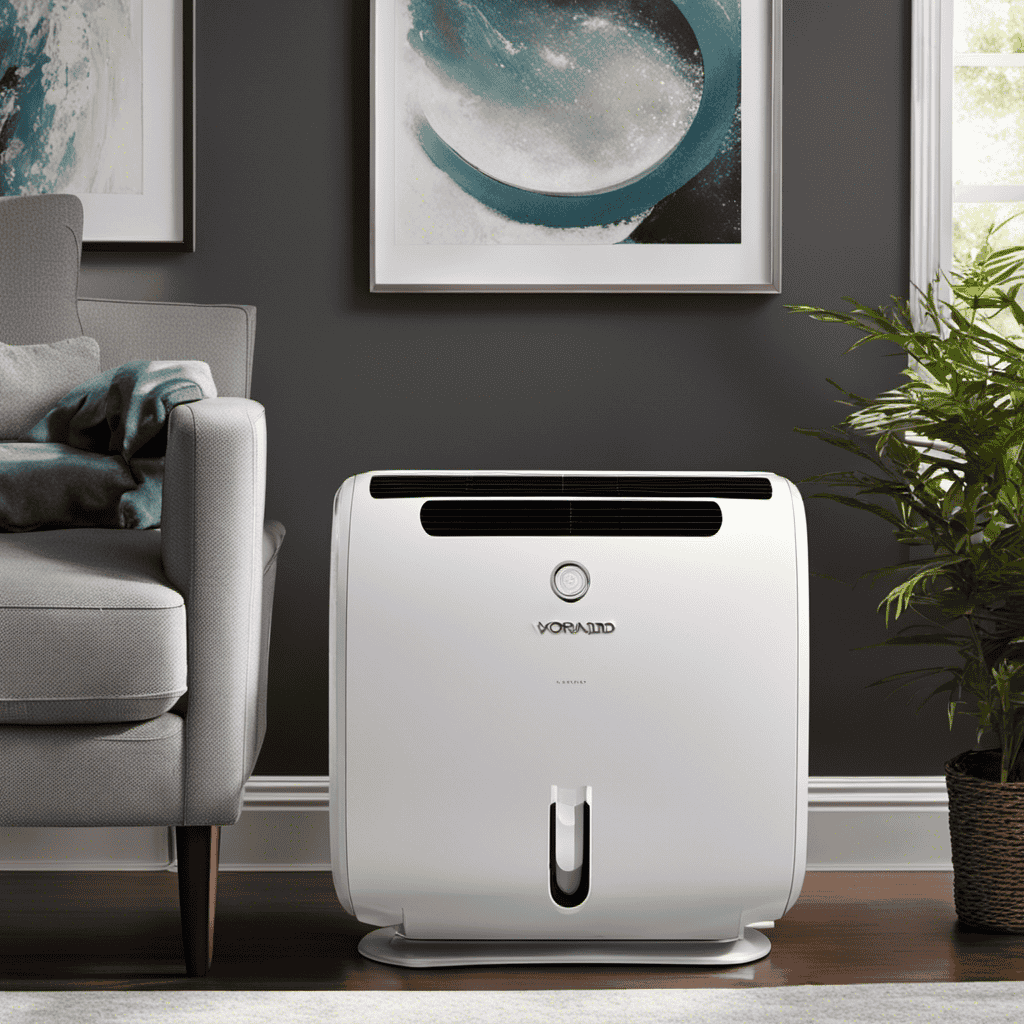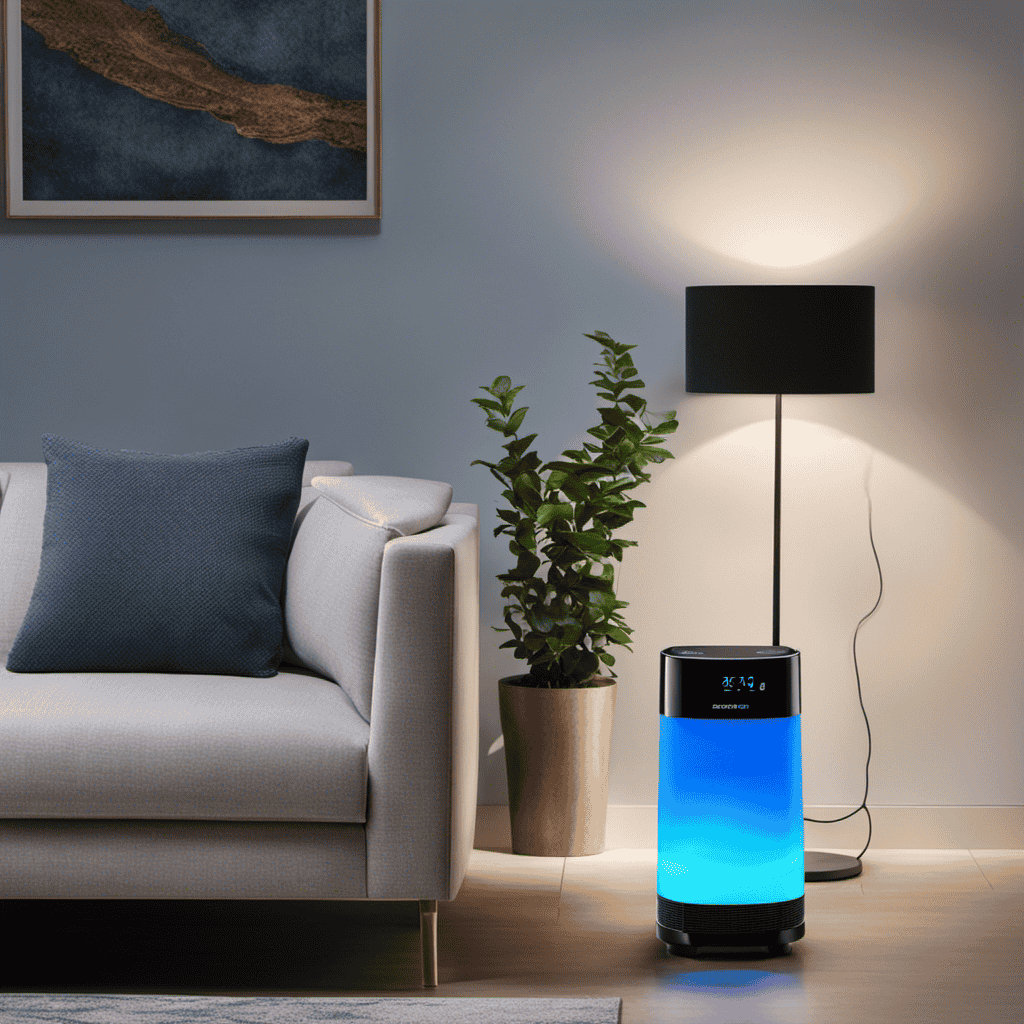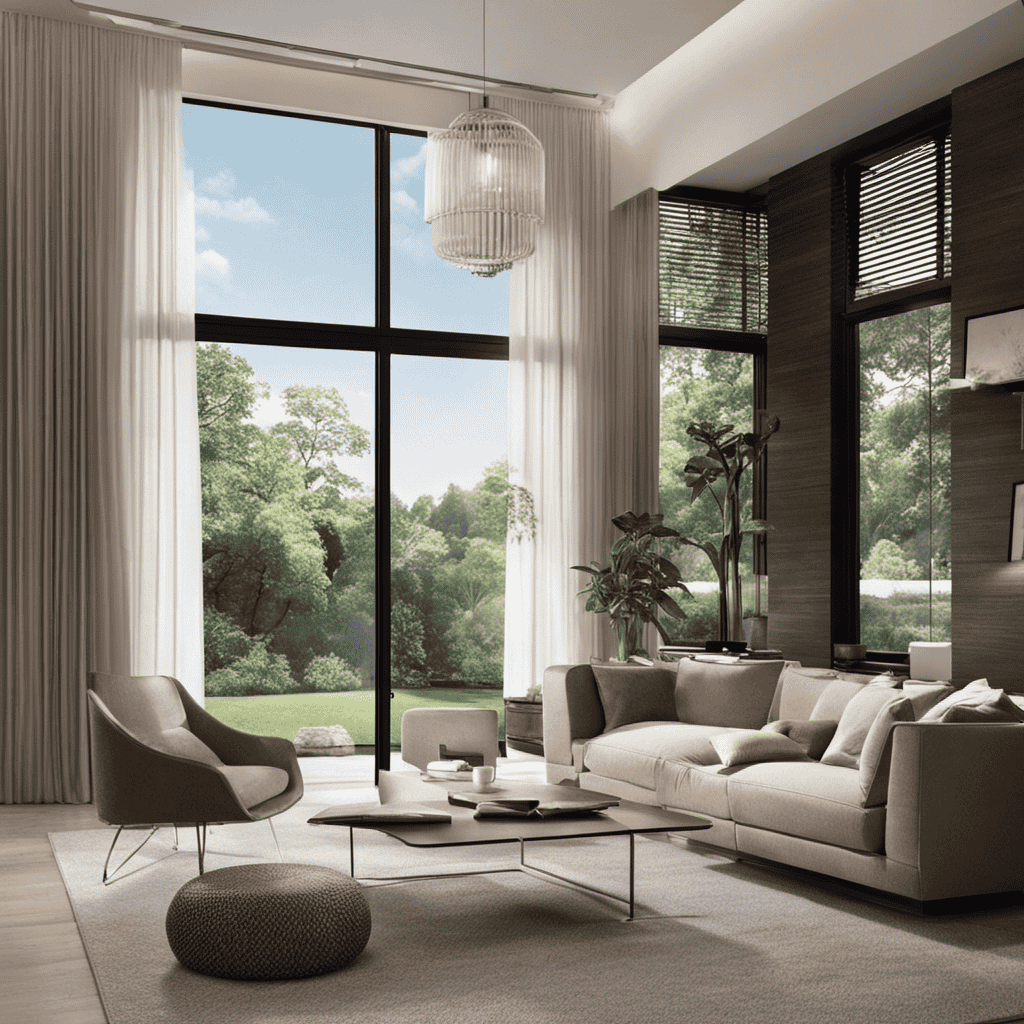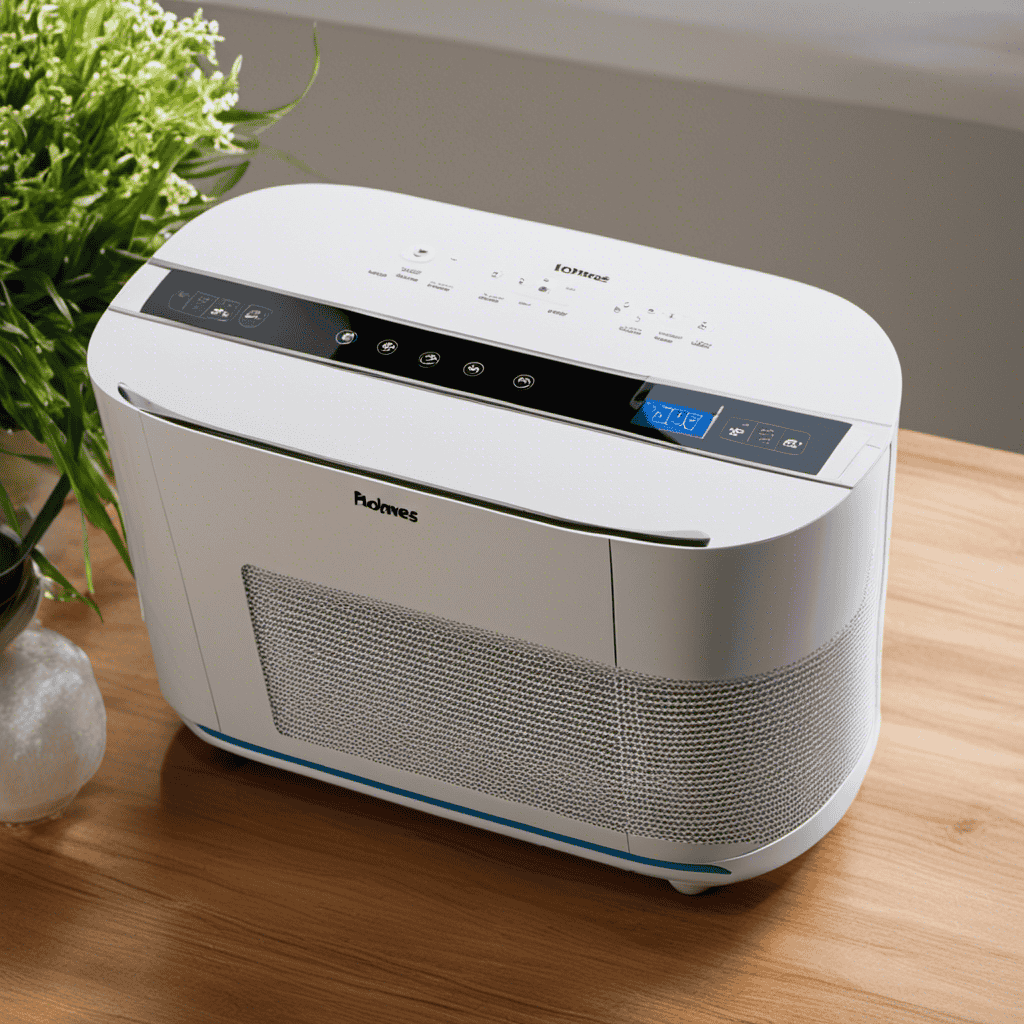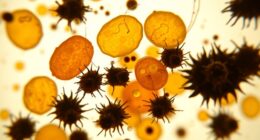When it comes to ensuring a healthy and clean environment in my home, finding the top large room air purifier is crucial. With numerous options on the market, it can be challenging to figure out which one is truly the best.
That’s why I’ve conducted extensive research and gathered evidence-based information to help guide you in making an informed decision. In this article, I will explore the factors to consider, the different types available, and the top features to look for in a large room air purifier.
Let’s dive in and find the perfect solution for your space.
Key Takeaways
- The size of the room and specific needs of your household should be considered when choosing a large room air purifier.
- Air purification in large spaces is important for maintaining a healthy indoor environment, removing allergens and pollutants, and improving air circulation.
- Different types of air purifiers, such as HEPA filters, activated carbon filters, and UV-C light, have different effectiveness in removing particles, odors, and bacteria.
- Determining the size of air purifier needed for your large room involves considering square footage, air changes per hour, ceiling height, windows, and pollutants/allergens.
Factors to Consider When Choosing a Large Room Air Purifier
When choosing a large room air purifier, you’ll want to consider factors such as the size of the room and the specific needs of your household.
Room size considerations are important because air purifiers are designed to work optimally within a specific square footage. It’s crucial to select a purifier that is suitable for the size of your room, as using an undersized purifier may not effectively clean the air, while an oversized one may lead to unnecessary energy consumption.
Additionally, air purifier placement is another key aspect to consider. Placing the purifier in a central location within the room ensures that the clean air is evenly distributed. It is recommended to place the purifier at least a foot away from walls and furniture to allow proper air circulation.
The Importance of Air Purification in Large Spaces
If you want to ensure clean and healthy air in your spacious area, it’s crucial to understand the significance of purifying the air in large spaces. Room ventilation and air quality monitoring play a vital role in maintaining a healthy indoor environment. Proper ventilation helps to remove pollutants and circulate fresh air, while air quality monitoring allows you to track and control the levels of contaminants in your space. To illustrate the importance of air purification in large spaces, consider the following table:
| Problem | Solution | Benefits |
|---|---|---|
| Poor Indoor Air Quality | Air Purifiers | Removes allergens, pollutants, and odors |
| Inadequate Ventilation | HVAC Systems | Improves air circulation and reduces humidity |
| Contaminated Air Ducts | Duct Cleaning | Prevents the spread of pollutants |
| Mold and Mildew Growth | Dehumidifiers | Controls moisture levels and prevents mold growth |
Understanding the Different Types of Air Purifiers for Large Rooms
To choose the right air purifier for your spacious area, it’s important to understand the various types available. When it comes to large rooms, you need a purifier that can effectively clean the air and cover the entire space.
Here are three types of air purifiers that are suitable for large rooms:
-
HEPA Filters: These purifiers use high-efficiency particulate air (HEPA) filters to trap particles as small as 0.3 microns. They are great for removing allergens, dust, and pet dander from the air.
-
Activated Carbon Filters: These filters are effective at removing odors, gases, and chemicals from the air. They work by adsorbing the pollutants onto the carbon surface.
-
UV-C Light: Some air purifiers use ultraviolet germicidal irradiation (UV-C) light to kill bacteria, viruses, and mold spores. This type of purifier can be especially beneficial for people with respiratory conditions.
When determining the room size for your air purifier, consider the square footage of the area and the air changes per hour (ACH) rating of the purifier. Place the purifier in a central location to ensure even distribution of clean air throughout the room.
How to Determine the Size of Air Purifier Needed for Your Large Room
When it comes to choosing the right air purifier for a large room, it’s essential to consider the room size calculation methods, air purifier coverage area, and the factors that can affect the size of the room.
To determine the size of the air purifier needed, you can use the square footage of the room as a starting point. However, it’s also crucial to consider other factors such as ceiling height, the number of windows, and the presence of any pollutants or allergens in the room.
Room Size Calculation Methods
The most common room size calculation methods for air purifiers are square footage and air changes per hour. Estimating the room size is crucial for selecting an air purifier that can effectively clean the air in a large space. Here are three key factors to consider when calculating the room size for an air purifier:
-
Square Footage: Measure the length and width of the room and multiply them to determine the square footage. This method provides a general guideline for selecting an air purifier based on room size.
-
Air Changes Per Hour: Determine the number of times the air in the room needs to be exchanged per hour. This calculation takes into account factors like pollution levels, allergies, and room occupancy.
-
Air Circulation Requirements: Consider the layout of the room, including furniture placement and airflow obstructions, to ensure proper air circulation throughout the space.
Air Purifier Coverage Area
Determining the appropriate coverage area of an air purifier is essential for effectively cleaning the air in a given space. When considering room size, it is important to take into account the air purifier’s Clean Air Delivery Rate (CADR), which measures its efficiency in removing pollutants.
The CADR is typically provided by the manufacturer and is based on standardized testing. Additionally, it is crucial to consider the placement of the air purifier within the room. Placing it in an area with good air circulation, such as near a doorway or in the center of the room, can help ensure that the purified air is evenly distributed. Avoiding obstructions, such as furniture or curtains, will also optimize the air purifier’s performance.
Factors Affecting Room Size
When considering the best large room air purifier, it’s important to take into account the room size requirements and optimal placement. The size of the room plays a crucial role in determining the effectiveness of an air purifier. Here are some factors to consider:
-
Room Size Requirements:
-
Calculate the square footage of the room to determine the appropriate air purifier size.
-
Look for air purifiers that are specifically designed for large rooms and have a high Clean Air Delivery Rate (CADR).
-
Consider the number of air changes per hour needed to effectively clean the air in the room.
-
Optimal Placement:
-
Place the air purifier in a central location to ensure maximum air circulation.
-
Avoid placing the purifier near walls or furniture that could obstruct airflow.
-
Determine the best height for the air purifier based on the location of pollutants in the room.
Top Features to Look for in a Large Room Air Purifier
One important factor to consider when choosing a large room air purifier is its coverage area. The size of the room plays a crucial role in determining the effectiveness of the air purifier in improving air quality.
A purifier with a coverage area that matches or exceeds the size of the room is essential for optimal performance. It ensures that all the air in the room is adequately filtered and purified, removing pollutants, allergens, and other harmful particles.
Additionally, a larger coverage area allows for better air circulation and distribution, ensuring that every corner of the room receives clean, fresh air.
Therefore, when selecting a large room air purifier, it is crucial to consider the room size and choose one that can effectively clean the entire space, thus improving the overall air quality.
The Best Air Purification Technologies for Large Rooms
When it comes to choosing the best air purification technologies for large rooms, it is essential to consider the effectiveness of HEPA filters versus activated carbon filters.
HEPA filters are highly efficient at removing microscopic particles.
Activated carbon filters excel at eliminating odors and harmful gases.
Additionally, UV-C for sterilization offers an additional layer of protection by killing bacteria and viruses.
Ozone-free ionization can effectively neutralize airborne pollutants without releasing harmful ozone into the environment.
HEPA Vs. Activated Carbon
If you have allergies, you’ll want to know that HEPA filters are great at capturing small particles, while activated carbon filters are effective at removing odors and chemicals. However, there are alternatives to activated carbon that can also be effective in air purification. Here are some key points to consider:
-
Activated carbon alternatives:
-
Zeolite: This mineral-based material has a porous structure that can effectively absorb odors and chemicals.
-
Potassium permanganate: This powerful oxidizing agent can break down and eliminate various pollutants in the air.
-
Charcoal: Similar to activated carbon, charcoal can absorb odors and chemicals, but it may have a shorter lifespan.
-
HEPA vs. electrostatic precipitators:
-
HEPA filters: These high-efficiency filters can trap particles as small as 0.3 microns with an efficiency of 99.97%.
-
Electrostatic precipitators: These filters use an electrical charge to attract and collect particles, but they may produce ozone as a byproduct.
Considering these options, it’s important to choose an air purifier that suits your specific needs and preferences.
UV-C for Sterilization
UV-C technology, also known as ultraviolet germicidal irradiation (UVGI), uses short-wavelength ultraviolet light to disrupt the DNA of microorganisms, rendering them unable to replicate and causing their death. UV-C can effectively sterilize surfaces and eliminate harmful bacteria and viruses. In air purification, UV-C can be used to kill airborne pathogens, such as bacteria, viruses, and mold spores. As air passes through the purifier, it is exposed to UV-C light, which neutralizes these harmful microorganisms.
The benefits of UV-C in air purification include improved indoor air quality, reduced transmission of infectious diseases, and decreased risk of respiratory infections. By utilizing UV-C technology, air purifiers can provide a more thorough and effective solution for sterilizing the air we breathe.
With UV-C’s ability to eliminate harmful pathogens, it sets the stage for the subsequent section on ozone-free ionization, another powerful method for air purification.
Ozone-Free Ionization
Ozone-free ionization, also known as bipolar ionization, utilizes charged ions to neutralize pollutants and improve indoor air quality. This innovative technology offers a promising alternative to traditional ionization methods that may produce harmful ozone.
Here are three reasons why ozone-free ionization is worth considering:
-
Improved air purification: Ozone-free ionization releases positive and negative ions into the air, which attach to pollutants and neutralize them. This process effectively reduces airborne particles, such as dust, pollen, and mold spores, leading to cleaner indoor air.
-
Odor elimination: By targeting and neutralizing volatile organic compounds (VOCs), ozone-free ionization helps eliminate unwanted odors caused by cooking, pets, or chemicals. This can greatly improve the overall freshness of indoor spaces.
-
Health benefits: Unlike ozone-generating ionization methods, ozone-free ionization is safer for human health. It does not produce harmful ozone, which can irritate the respiratory system and exacerbate asthma symptoms.
Considering these benefits, ozone-free ionization presents a promising and safe alternative to traditional ionization methods.
Noise Levels: Finding a Quiet Air Purifier for Your Large Room
When looking for a quiet air purifier for your large room, it’s important to consider the noise levels emitted by different models. Air purifier noise levels can vary significantly depending on the type of technology used and the design of the unit.
To ensure a peaceful environment, manufacturers have employed various noise reduction techniques. One common technique is the use of sound-absorbing materials in the construction of the purifier. These materials help to dampen the noise produced by the fan and other internal components. Additionally, some models incorporate advanced fan designs that minimize turbulence and reduce noise.
Furthermore, the placement of the air purifier can also affect noise levels. Placing the unit away from walls or furniture can help to minimize reverberation and further reduce noise.
Considering these factors can help you find a quiet air purifier that effectively cleans the air in your large room without disrupting your peace and quiet.
Energy Efficiency: Choosing an Eco-Friendly Air Purifier for Large Spaces
To make sure you’re choosing an eco-friendly option for large spaces, it’s essential to consider the energy efficiency of different air purifier models.
When it comes to room layout and air purifier placement, there are a few key factors to keep in mind:
-
Size of the room: Consider the square footage of the room when selecting an air purifier. Larger rooms may require more powerful models to effectively clean the air.
-
Airflow and circulation: Proper placement of the air purifier is crucial for optimal performance. Ensure that the purifier is positioned in an area where it can effectively circulate the air throughout the entire room.
-
Avoid obstructing objects: Keep the air purifier away from any objects that may obstruct the airflow, such as curtains or furniture.
The Best Air Purifiers for Allergies in Large Rooms
For those with allergies in need of relief, you’ll want to consider air purifiers designed specifically for large rooms. When it comes to tackling allergens in a large space, room layout plays a crucial role. The placement of furniture, doors, and windows can affect the airflow and distribution of pollutants.
To ensure optimal performance, it’s important to choose an air purifier that can handle the size of your room. Regular air purifier maintenance is also essential in maintaining its effectiveness. This includes cleaning or replacing filters, checking for any malfunctions, and keeping the unit free from dust and debris.
Combatting Odors: Air Purifiers for Large Rooms With Pets or Smokers
If you have pets or smokers in your home, it’s important to choose an air purifier that can effectively combat odors in large rooms. Odors from pet dander and cigarette smoke can linger in the air, causing discomfort and potential health issues. Here are three reasons why selecting the right air purifier is crucial:
-
Advanced filtration technology: Look for an air purifier that utilizes a combination of HEPA and activated carbon filters. HEPA filters are designed to capture tiny particles, such as pet dander, while activated carbon filters are effective at absorbing odors from cigarette smoke.
-
High Clean Air Delivery Rate (CADR): The CADR indicates how quickly and efficiently an air purifier can clean the air in a specific room size. Choose an air purifier with a high CADR for large rooms to ensure optimal odor removal.
-
Multiple air changes per hour: To effectively combat odors, your air purifier should be able to provide multiple air changes per hour. This means that the entire volume of air in the room is filtered multiple times, ensuring that odors are continuously removed.
Air Purifiers for Large Rooms With Mold and Mildew Issues
When dealing with mold and mildew issues in your home, it’s important to choose an air purifier that effectively targets and eliminates these harmful contaminants. Mold and mildew can cause a variety of health problems, including respiratory issues and allergies. To combat these issues, you need an air purifier that is specifically designed to remove mold spores and mildew from the air. Look for a purifier with a HEPA filter, as it is capable of capturing particles as small as 0.3 microns, including mold spores. Additionally, consider choosing an air purifier with an activated carbon filter to remove any odors associated with mold and mildew. Here is a comparison table of two top air purifiers for large rooms with mold and mildew issues:
| Air Purifier Model | Coverage Area | Key Features |
|---|---|---|
| Model A | Up to 500 square feet | HEPA filter, activated carbon filter, UV-C light |
| Model B | Up to 700 square feet | HEPA filter, activated carbon filter, ionizer |
Multi-Stage Filtration Systems: What to Look for in a Large Room Air Purifier
To ensure cleaner air in your home, consider looking for a multi-stage filtration system in a purifier designed for larger rooms. These systems are specifically designed to effectively remove various pollutants from the air, ensuring better indoor air quality.
Here are some key features to look for in a large room air purifier with a multi-stage filtration system:
-
HEPA Filters: These filters are highly effective in capturing small particles, including dust, pollen, pet dander, and mold spores.
-
Activated Carbon Filters: These filters are designed to remove odors and volatile organic compounds (VOCs) from the air, improving the overall air quality.
-
Pre-Filters: These filters trap larger particles, such as hair and lint, preventing them from clogging the main filters and prolonging their lifespan.
The Benefits of Smart Air Purifiers for Large Rooms
Smart air purifiers offer numerous benefits for larger rooms. They have the ability to monitor and control air quality levels remotely. With smart home integration, these purifiers provide a convenient and efficient way to improve indoor air quality.
By connecting to Wi-Fi, smart air purifiers can be controlled through smartphone apps or voice assistants. This allows users to adjust settings and monitor air quality from anywhere. These devices are equipped with sensors that detect various pollutants such as dust, pollen, and pet dander. Real-time data is then displayed on the app, providing insights into the current air quality levels.
This information helps users make informed decisions about when to adjust fan speed or activate additional purification modes. Smart air purifiers take air quality monitoring to the next level, ensuring a healthier living environment for larger rooms.
Now, let’s explore budget-friendly options for affordable large room air purifiers.
Budget-Friendly Options: Affordable Large Room Air Purifiers
When it comes to finding a budget-friendly air purifier for a large room, it’s important to consider cost-effective filtration technology that still delivers high performance.
I have researched and found that there are options available that offer both a low price and affordable maintenance, without compromising on the quality of the filters.
These filters are designed to effectively remove allergens, pollutants, and odors from the air, making them a practical and economical choice for those on a budget.
Cost-Effective Filtration Technology
One great option for cost-effective filtration technology in large room air purifiers is the HEPA filter. HEPA stands for High-Efficiency Particulate Air, and these filters are designed to capture particles as small as 0.3 microns with an efficiency of 99.97%.
Here are three reasons why HEPA filters are an excellent choice for improving air quality in large rooms:
-
Superior Filtration: HEPA filters are highly efficient in removing common pollutants such as dust, pollen, pet dander, and mold spores from the air, which can greatly improve air quality in any room size.
-
Increased Airflow: HEPA filters are designed to allow for optimal airflow, ensuring that the air is properly circulated and filtered throughout the entire room.
-
Long Lifespan: HEPA filters have a longer lifespan compared to other filtration technologies, reducing the need for frequent filter replacements and saving you money in the long run.
With their ability to effectively filter out airborne particles and their cost-effectiveness, HEPA filters are a reliable choice for large room air purifiers to promote cleaner and healthier indoor air.
High Performance, Low Price
If you’re looking for an affordable option that delivers high performance, consider a filtration technology that offers both quality and value. One such option is the HEPA (High Efficiency Particulate Air) filter. HEPA filters are designed to capture particles as small as 0.3 microns, including dust, pollen, pet dander, and mold spores. They can remove up to 99.97% of airborne particles, ensuring clean and fresh air in your large room. Additionally, HEPA filters require low maintenance, with most models only needing a filter replacement every 6 to 12 months. This makes them a cost-effective choice in the long run. With their high performance and low maintenance, HEPA filters are an excellent option for anyone seeking an efficient and affordable air purification solution.
| Key Features | High Performance | Low Maintenance |
|---|---|---|
| Particle Size | 0.3 microns | |
| Particle Removal Efficiency | Up to 99.97% | |
| Maintenance | Filter replacement every 6-12 months | |
| Total Cost | Affordable | |
| Application | Large rooms |
Affordable Maintenance and Filters
In my search for the best large room air purifier, affordability is a key factor. I want a purifier that performs well and has a low price, while also being cost-effective in terms of maintenance. I’ve been looking for options with long-lasting filters to avoid constantly replacing them and spending a fortune on maintenance.
Here are some advantages of affordable maintenance and long-lasting filters:
-
Cost savings: By choosing a purifier with cost-effective maintenance and long-lasting filters, you can save money in the long run. You won’t have to constantly replace filters or spend a fortune on maintenance.
-
Convenience: With long-lasting filters, you won’t have to worry about frequently changing them. This makes maintenance more convenient and hassle-free.
-
Sustainability: By using filters that last longer, you can reduce waste and contribute to a more sustainable lifestyle.
When considering a large room air purifier, it’s important to factor in the cost-effective maintenance and long-lasting filters for a practical and economical choice.
Comparing the Top-Rated Large Room Air Purifiers on the Market
When comparing the top-rated large room air purifiers on the market, it’s important to consider factors such as CADR, filtration technology, and noise levels.
One key factor to consider is the room size calculation. Air purifiers are designed to clean the air in a specific room size, so it’s essential to choose a purifier that is suitable for your room dimensions. This calculation ensures optimal performance and clean air throughout the entire space.
Additionally, noise levels are crucial to consider, especially if you plan to use the air purifier in areas where silence is essential, like the bedroom or study. Look for air purifiers with low decibel ratings to ensure a peaceful and undisturbed environment while still enjoying the benefits of purified air.
What Features Make a Large Room Air Purifier Different from a Regular Room Air Purifier?
When comparing large room air purifier options to regular room air purifiers, size, capacity, and coverage area are key distinguishing features. The best room air purifier options for larger spaces offer higher CADR (clean air delivery rate) and can effectively clean the air in larger rooms, making them suitable for bigger areas.
Frequently Asked Questions
Can an Air Purifier Completely Eliminate All Allergens and Pollutants in a Large Room?
An air purifier can significantly reduce allergens and pollutants in a large room, but it may not completely eliminate them. While it offers many benefits, its effectiveness depends on factors such as filtration technology and room size.
How Often Do I Need to Change the Filters in a Large Room Air Purifier?
I change the filters in my large room air purifier regularly to ensure optimal performance. Signs that indicate the filters need to be replaced include reduced airflow, increased noise, and a decrease in air quality.
Can a Large Room Air Purifier Help With Asthma Symptoms?
Yes, a large room air purifier can help with asthma symptoms. It improves indoor air quality by reducing dust and pet dander, which are common triggers for asthma. Numerous scientific studies support this claim.
Are There Any Specific Safety Considerations When Using a Large Room Air Purifier?
When using a large room air purifier, it is important to consider safety precautions and maintenance requirements. Regularly clean or replace filters, and ensure the unit is placed in a well-ventilated area.
Can a Large Room Air Purifier Remove Viruses and Bacteria From the Air?
Yes, a large room air purifier can effectively remove viruses and bacteria from the air. The benefits of air purification include improved indoor air quality and reduction in the spread of airborne illnesses.
Conclusion
After careful analysis and research, it’s evident that choosing the best large room air purifier is crucial for optimal air quality.
With the various types available, it’s essential to consider factors such as size, filtration system, and budget.
Smart air purifiers have proven to be beneficial, offering convenience and advanced features. Additionally, multi-stage filtration systems ensure thorough purification.
In conclusion, investing in a top-rated air purifier guarantees a clean and healthy environment, ultimately improving overall well-being.
So, let’s breathe in fresh air and embrace a healthier lifestyle.
